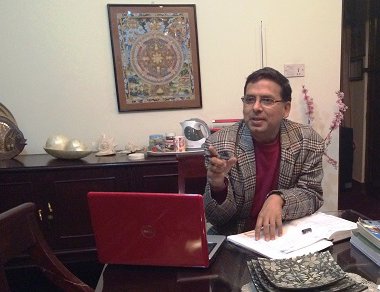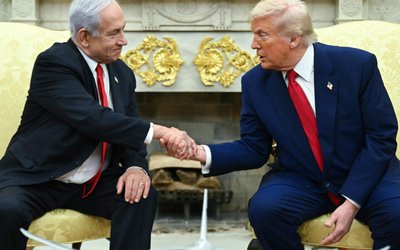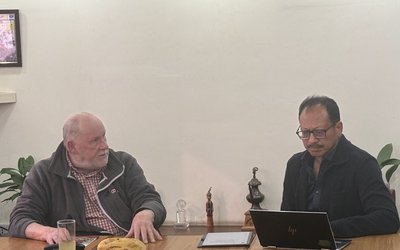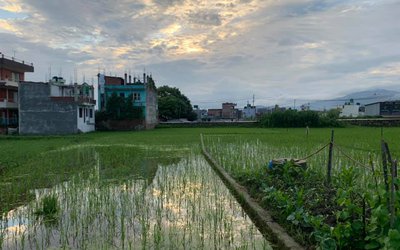
What is the latest update on constitution building?
The update is that there is no real update. The last important development was the joint proposal of Nepali Congress (NC) and the CPN (UML) in early November to solve the existing contentious constitutional issues. The proposal contained their position on state restructuring, system of governance, electoral model, and judicial system for resolution of federal disputes.
The proposal was registered by the ruling coalition at the Constituent Assembly (CA) Secretariat as a point of departure for further processes. It was to be further discussed at CPDCC (the Constitutional Political Dialogue and Consensus Committee), and then sent to the full house complying with the Committee procedures. This could not materialise.
What did the CPDCC procedure entailed? Why were these procedures not complied with in your opinion?
According to CA procedural rules, the proposal must have been discussed and put to vote at the Committee. However, it was not granted acceptance. The reasons are, in fact, all political.
CPDCC Chairperson Dr Baburam Bhattarai feared giving it the right to passage in light of the widespread dissent from his own party and others in the opposition. The ruling parties were criticized by his Party UCPN (M) and others for preparing the proposal against the past agreements. They warned against starting the Committee procedure for giving it an exit. After weeks of negotiations, he (Dr. Bhattarai) conceded to send it to the full house, along with other competing proposals as well, but not with any back up from the committee procedures. We are well aware of Bhattarai's claims that the discussion and voting at the Committee was put off in a bid to avoid further confrontation among political parties.
Subsequently, they were sent just for the information of the full house. Had it been put to discussion in the Committee, and then to voting, the proposal of the ruling coalition would have been conveniently passed, and sent to the full house for remaining procedures.
What is your comment on the quality of the proposal?
As a student of constitutional law, I do not have specific comments on the proposed outlines. A Westminster model of parliamentary democracy with German feature of the constructive vote of no-confidence is not a bad idea for a stable government. A seven province federalization is also practical; although I believe adding another couple of provinces is a viable compromise if that leads to a consensus. The idea of Constitutional Bench at Supreme Court is also okay. Furthermore, the mixed electoral system has remained acceptable to all. They all can be tried. In general, what has been proposed is based on liberal values of democracy and constitutionalism.
So you mean there are no comments?
No, this is not what I mean. These features do not seem to be a problem on their own. However, the ruling coalition should work a little more and be able to explain how they plan to respond to identity politics and the demand, by Janjatis and Madhesis, for autonomous administration.
It is possible to establish identity structures within the declared provinces, and also solve all the contentious federalization issues including naming of these structures, their autonomy and linkages with the provincial and national legislatures. The proposal does not have clear indication on how they want to make sure that the national and provincial structures have proportional inclusion in the proposed system.
In order for inclusive democracy to thrive, the system of inclusion, representation and the regulation of political parties must be clearly defined. However, the current proposal is not much reassuring as far as these issues are concerned.
How is it possible to establish identity structures within the declared provinces? Will it be acceptable?
As I've stated earlier, the NC-UML proposal has set forward seven provinces at present. Although, judging from the ruling coalition's willingness for negotiations on this matter, pertaining to political consensus, further provinces could also be added in the near future.
Even if there is no change in the number of provinces, due to any other reason, the proposed provinces could be demarcated in a way that makes it possible for different identity-based regions in each province. This is a viable mid-way. If this is acceptable, it is possible to design at least two dozen of identity based regions in the country. This means every province will have at least 3 to 4 regions depending on its geographical size and population. In other words, not just the seven dominant ethnic groups, but many groups along with the 'dalits' and Muslims will be able to get autonomous regions.
Nobody will object to having ethnic names for these regions as long as the province continues to have the presently proposed names. This will establish ethnic identity as well as meet the concerns for the province as commonwealth of all castes and tribes.
This means you think the present names for the proposed provinces are fine?
They are fine as long as they are consensually appropriate. We cannot say that Sagarmatha province is a bad name or Karnali province does not give a good impression.
The issue is that some ethnic groups want to establish their historical identity by way of provincial names; and others have harboured misconceptions that it will be exclusionary for people who are not from that group. So you have to find a mutually acceptable solution if you want to settle it amicably.
There could be many local ethnic names which could be considered for all these provinces, but the alternatives must not annoy the majority people living out there. Judging from Nepal's history, most of the districts' names like Kaski, Myagdi, Dolpa, Manang, Saptari or Namche have ethnic origin, and they have never been an issue in Nepal.
In a way you are advocating about four-tier federal system in Nepal?
Not really! I do not advocate anything. The fundamental criteria are that there must be a workable democratic system which can protect national interest as well.
And what I am envisaging is not a four tier arrangement. It is a three tier arrangement, where apart from national government, there is provincial set up, and each province will have autonomous regions within it that will enable self-government focusing on ethnic requirements. All the autonomous regions will be represented in the provincial legislature and national parliament. When you have autonomous regions you need not constitute smaller self-government units to compete with them.
Obviously, there will be municipalities with diverse populations standing on their own feet as self government units. But all rural areas will be a part of one of the autonomous regions. They will have a sort of autonomous administration under the provincial government.
Will that fulfil the demands of the Janjatis?
This could be a compromise solution. In addition, the leaders at the top level should sit with Janjatis and convince them with appropriate alternative features for their identity and empowerment. Mainly, the leaders need to address pertinent issues like formation of ethnicity dominant upper house in the bicameral national legislature, carefully crafted electoral constituencies, guarantee of diversity in the use of their languages, recognition of their traditional court system, implementation of the rights of ethnic and marginalized groups, their claims for ownership in the land, water and forest in all appropriate cases, the right to self determination, the promotion of their skills, local taxation, and above all, internal democratization of political parties, and so on. Is this also not what the Madhesis want?
Madhesis have their own logic for one Madhes, or something close to this?
I think the provincial proposal on Terai is fine. It divides Terai into two provinces. The tracts resided by hill people have been attached to the hills. This establishes Madhesi identity and also assures sustainability and helps make the populations in all provinces in proportionate size.
How to manage electoral constituencies for the national and provincial level elections?
My suggestion is that the new constitution would have to lay down all basic norms about the autonomous regions. When demarcating electoral constituencies, efforts should be made to make larger constituencies that can ensure ethnic representation. Constituencies may be offered to Women, Dalits and ethno-cultural groups on rotational basis where necessary. They can change the current scenario of representation positively. There is ample room for reformation.
So obviously you suggest some changes in the proposed representation system.
It is not enough to continue with what is known in Nepal as the mixed system. Despite certain visible changes, the so called mixed system that Nepal started in 2008 has not worked well.
On the ‘first past the post’ (FPTP) part, the constitutional assurance for inclusive representation was not effectively carried out. On the proportional representation part of the election, or the LIST PR system, which was created to make the CA inclusive for women, Madhesis, Janajatis, Dalits, Backward Regions and others, the electoral quotas were introduced not only for those who were traditionally disadvantaged, but also for the elite as well as predominantly represented groups.
Moreover, the Closed List, contrary to international practice, was not the priority list which must have been followed.
Why is there a problem as long as it is proportional?
This is the issue. There must have been effort to target these quotas as affirmative action for otherwise excluded groups, and secure diverse representation that the country needs.
As a matter of fact, many deprived communities did not find the opportunity for representation at all. Affirmative action should have been maintained for such groups whose electorate has been too small to secure their representation. But the system was repeated again in 2013 elections. This is what is being generally proposed again for the new constitution by the ruling coalition.
They could have thought of providing affirmative action to some excluded groups only for a limited time whereas assuring a more permanent protection to others.
So the provision of affirmative action should be time bound?
This should be left to the laws to be worked out by the parliament. Such a law should provide that politically excluded groups who have consistently been underrepresented under systems of representation to parliament, and which do not have affirmative action, are adequately represented. This is not a new thing.
A Norwegian expert, Kåre Vollan, working with the Election Commission has already submitted his opinion on this matter. According to him, if the mixed electoral system is adopted in Nepal and the affirmative action is applied to the proportional representation system, then the results of the FPTP could form a measuring scale for monitoring proportionate representation. This means that the electoral system could continue with affirmative action as long as the FPTP produces disproportionate representation from all groups on a consistent basis.
In the same vein, affirmative action could be removed once proportionate representation, including the perennially underrepresented group, is achieved on a consistent basis. On the other hand, if affirmative action is applied to both FPTP and the List PR, then indirect assessment of political participation at large may be used as a measuring scale.
In either case, a periodic assessment will be necessary to check if affirmative action is needed any longer.
Why is the NC-UML coalition so keen about giving continuity to parliamentary system? Is it not stubbornness on their part for no apparent benefit?
I also consider parliamentary system as a good system for Nepal. As the saying goes, "Better the devil you know than the devil you don't know".
We have experience in a parliamentary system. Also, I believe that a parliamentary system promotes diversity and pluralism. We know where the shoe pinches. So we can reform the existing system with our own insight.
When I provided a model constitution to the Constitution Assembly back in 2009, I also thought that the system could be continued, with necessary reforms. I proposed several new features including the code of conduct for the Ministers, limit on their numbers, some norms for ministerial advisors, and so on.
But, I defended the power of a prime minister to dissolve the House of Representatives and the vote of no confidence provision on various grounds.
So you do not hold on to it now?
Yes, I am not defending it anymore. In view of the conflicting positions between parties, although none of them are principled, I do not want to lay my emphasis on any form of government.
My only suggestion is that if you want to go for presidential system: go for the American model. If it is mixed system, go for the French model. The system of directly elected prime minister that Israel once practised is a very poor system. That is not a solution to our lawlessness and governmental instabilities. When the political factors of instabilities are around, and the rule of law becomes the victim of politicians, you cannot solve the problem just by creating a fixed term executive. Israel itself could not sustain the change.
I do not suggest the parties to venture around underdeveloped models, or try any new form of government. And the Maoist model is a very dangerous model. I do not recommend it.
The good thing about an established democratic model is that it gives you opportunity to learn from others' experience. You have a comparative advantage whilst fighting against the same vices which have already been overcome by others.
You talked about the German model of the form of government that NC-UML proposal has recommended. How is it?
In fact, there is little difference between German and Westminster model of parliamentary system. The German model is also the British model.
However, based on their own experience with the Weimar Constitution, and the proliferating political parties, stable governments were becoming increasingly difficult in Germany. They faced much instability after the World War I. This is the reason why they developed the concept of constructive vote of no-confidence. This made it obligatory that a coalition that wanted to get rid of the prime minister through the parliament had to propose a new prime minister to replace him or her through the same resolution. The idea is great. The system has moved on despite some complications in early years.
If parliamentary system is to be approved, this feature will certainly be helpful. Of course, as I said, stability depends on how you resolve political problems. In Nepal, this also means how you tackle your immediate neighbours.
What do you say about British Ambassador Andrew James Sparkes' advise on religious conversion?
Nepal has a high level of religious tolerance. The freedom of religion is guaranteed to all. The state is already a secular state. The situation will continue to improve as we go along.
It is not good to do anything that helps develop militancy among the dominant Hindu majority in the country. Remember always that Talibans were not Talibans historically. Hindus are already worried about the ongoing level of conversion in Nepal. The advice of British Ambassador provides fuel to those who think the 'conversion industry' has been financially supported by the Europeans. They think 'conversions' mean 'forced conversation.'
Not just Himalayan Hinduism, but also the Kiranti religion and Buddhism in the high mountains and Himalayan regions are very renowned cultural property of Nepal. The Hindus will not want these properties to be shattered. They do not change the identity and religions of others. Also, there is no concept of church and proselytization here. They want to see reciprocity in this regard.
Do you believe that these solutions are acceptable to the ruling coalition or those in the opposition?
I am not sure. They are just some possible scenario for negotiated settlement. They are not the best solution for sure. But this is not the end of the story.
Constitution making is a dynamic process. You can never accomplish it at one stroke. A new constitution will also provide the political parties new grounds for politics, new electoral mandate and new structure for future negotiations. This is the norm in every system that has endured democratically.
Unfortunately, in Nepal, the regard for democratic process is minimal and this has led to political deadlocks in the past as well as the current impasse.
Do you mean Article 70 process for passing the new constitution must be accomplished?
Yes, it is good to do so. A transparent process always has clear advantages in situations like ours. There has been too much of dark room negotiations.An open parliamentary process will give opportunity to all legitimate forces to discuss and oppose within the house itself. Article 70 does not mean you have to pass the document quickly. However, it will keep everybody reminding their strength in the house. Had this been done during CA – I, it would have been able to adopt the constitution.
In that case, the Nepali Congress and UML would have already amended the new constitution according to their new mandate.
Finally, is it possible to have the constitution on or by January 22?
Anything is possible. If the draft constitution is promulgated by January 22, without giving people the opportunity to comment on this, the draft should in that case be put to a referendum before it is enforced. This is also a sort of popular process.
.
- MELAMCHI WATER SUPPLY: No Interruption During Monsoon
- Jun 25, 2025
- KOREAN RETURNEES: Successful Integration
- Jun 25, 2025
- UPPER TRISHULI-1: Engaging With Local
- Jun 25, 2025
- IME GROUP: Twenty Five Years Of Journey
- Jun 24, 2025
- NEPAL’S AIR POLLUTION: A Growing Health Concern
- Jun 24, 2025















